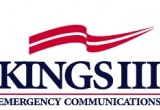
Kings III Emergency Communications has adopted a $17 minimum wage for all employees, building on Oregon, New York and California law raising the minimum wage to $15 per hour, leading advocates from business to meet national living wage mandates. Some business leaders and politicians, however, argued that companies, especially small businesses, could not absorb the hike and remain profitable. Businesses like Kings III and SoloProtect are proving otherwise.
Dallas, Texas, April 13, 2016 (Newswire.com) - The minimum wage is up for review. New laws creating a $15 minimum wage in Oregon, New York and California seized headlines last month and energized advocates for a national living wage mandate. Some business leaders and politicians, however, argued that companies, especially small businesses, could not absorb the hike and remain profitable.
Missing from the debate was mention of a growing roster of small private companies to large publicly traded corporations whose owners and CEOs voted with their company checkbooks to raise pay to well above the required minimum. Many did so a year or more before state legislatures took action.
At least half the people on Earth, perhaps more, don't make a living wage. We can't help them all, but we can help those who are closest to us.
George Broady, Chairman, Kings III Emergency Communications
One such company is Dallas-based Kings III Emergency Communications, which provides all inclusive emergency help phone solutions, maintenance and monitoring services, and its subsidiary SoloProtect, a turnkey provider of worker safety solutions. Last May, owner George Broady announced to his employees that everyone working for Kings III and SoloProtect would make at least $17 an hour and those already making above a certain threshold would add at least $2,000 to their paychecks. He said the increase would provide a proper living wage to all of his nearly 200 workers, including the more than 60 in Europe.
Like other business leaders who have taken similar steps, Broady cited his belief that successful companies are obligated to share the wealth generated by the work of its employees, and a need to ensure that they earned enough to cover basic living expenses and provide for their families.
“At least half the people on Earth, perhaps more, don't make a living wage,” Broady told his employees at a meeting. “We can't help them all, but we can help those who are closest to us. I would like to start by helping you; those who have helped me make more than I deserve.”
To warm applause at the meeting and via online media from Europe, he announced, “The minimum wage at Kings III and SoloProtect will be $17 an hour.”
About Kings III Emergency Communications & SoloProtect Lone Worker Safety Solutions
In the US, there are 900,000 elevators, each serving an average of 20,000 people, collectively making 18 billion passenger trips per year. With more than 25 years experience, working with over 40,000 customers, Kings III is the nation’s only full service provider of emergency communication solutions, providing help phone monitoring services for elevator phones, pool phones and other emergency phones throughout the U.S. and Canada.
In 2013, Kings III acquired SoloProtect and has expanded into the worker safety field, marrying a proven worker safety device with its own proven emergency communications expertise to provide an all-inclusive best of breed solution that Kings III customers have come to expect. The SoloProtect solution allows employers to empower their lone working staff to summon an immediate, reliable response at the push of a button whenever they may feel at risk.
SoloProtect has deployed over 150,000 of its devices that monitor lone workers and are able to summon help from its emergency response centers. These services rely on dedicated GPS (global positioning system) location devices that carry alarm buttons and man-down detection sensors.
In the lone worker safety monitoring segment alone, Berg Insight, www.berginsight.com, predicts the lone worker monitoring industry in both Europe and North America will rise from 0.7 million in 2013 to 2.2 million users by 2020.
Source: Kings III Emergency Communications
Share:




